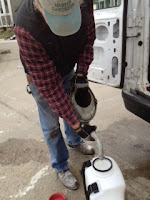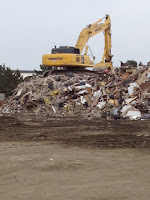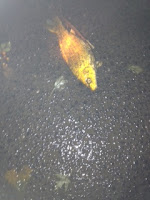The Faces of Sandy
“A
change in the weather is sufficient to recreate the world and ourselves,”
Marcel Proust
It is the three-month mark since Superstorm Sandy and her
evil sister, Athena, hit the east coast.
The airwaves have been filled with benchmark updates - -
charting what progress, if any, has been achieved.
NPR launched a series: “Follow the #CoastCheckRoadtrip to
check in on coastal communities three
months after Sandy.
At each stop, they’ll share photos and stories of people
they meet.”
Yesterday,
Congress approved the $50.5 billion Superstorm Sandy aid/loans – more than 10
weeks or
three months
late…
Me and my family’s Sandy experience at our country home in
the Garden State ranged from detailed pre-storm preparation to the storm’s
three-act performance: the fury began early enough with power unexpectedly
going out before Sandy made landfall.
Her second act was an unforgettable rage with howling, scary
winds; storm surge high tides and watching the transformers blow up with
random, fireworks-style drama.
We left my mothers high-rise bunker of a condo late that
night in between tides to find dead fish in the street and boats and piers not
on the docks but in the streets or rammed up against houses like heeling toy
boats in a boardwalk amusement ride.
 |
| boat in a front yard |
 |
| dock at your back door Downed power lines danced… Streetlights were down and so were the trees… Oh the heartbreak of the trees. |
My mother lost her car to the electrical system shorting out
and the car flooding.
So did my cousin’s
rental car. She was visiting from
Florida…
Our home is up high enough that the tides could not reach it. We were spared falling trees.
My garden design clients were not so lucky. So many of their homes are right on the
water: the bay, the rivers and the ocean.
Following Sandy’s temper tantrum, we drove the next day to check
out the damage to the client’s yards and gardens. I shared some of these photos in a previous
post.
 |
| This is one side of turf & Italian marble parking court damaged by rain & cars. We remade these |
Here are few more: I
have soooo many.
The searing images never failed to numb.
I couldn’t stop taking pictures.
 |
| WTF! That spot after homeowners CUT down More trees that led to landslide and closed road! |
 |
| Tree slaughter should be a crime |
We volunteered feeding first responders in Atlantic Highlands and helped clean up and tear out walls at homes in the Highlands.
We donated clothes.
There were mountains of clothing and household item
donations to boggle the mind. Everybody who could, wanted to help…The other
half had lost most everything.
As days wore on, the routine was to clean up local
communities, look for power for mobile phones, work as much as one could before
the sun set – as the candles were good for the mood-enhancing dinner table and
spot lighting only. Note - gas stoves are good and work in the power outage; must
get coffee press. Could always boil water for tea.
As it got colder with the calendar pages blowing ahead, the
chiminea was used more than usual. We used the indoor gas fireplace too much
too. At the same time, the ice in the
freezer and the coolers was going away… So the food was getting to be a
challenge.
We had the opportunity to purchase a generator 10 days in from neighbor's school friend parents.
At that point in time, generators near us were rare as hen's teeth. Still I hesitate. Then, looking at my mother almost INTO the gas fireplace because it was cold (and not having taken a shower in a week because she didn't want to even think about removing warm chothes - I didn't hesitate and responded, "I'll take it."
Of course, not more than 20 hours later - the power came back on...
The worst thing? With
no power, there was no music. I really
missed the music.
After the Nor’easter passed, my Duchess Designs’ garden team
and me was able to start some clean up at the client’s gardens.
First, I visited every one of my garden client’s properties
the day after to assess the damage and the second visit was to develop a punch
list.
In one case the tree damage was so vast and overwhelming we
were prevented from getting to the property.
The homeowner was hosting river friends who were evacuated only to find
themselves in yet another weather stranglehold: a woodland lock-down.
In other cases, such as Sea Bright, the state/government
didn’t allow us onto the barrier island. With good reason.
But I still managed to get some photos from the Rumson side,
across the Shrewsbury River, in order to show my clients.
I did have to cross into a private property sporting a sign
that read, “No Trespassing.”
No matter.
 |
| boat seekers on our terrace wall |
Besides, we have a veritable caucus in our yard with boat
owners locked out of the destroyed marina trying to get to see if their boats
had survived. We could see their panic
and welcomed our opportunity to help…
So I pursued the hunt for photos of my client’s
situation.
I surmised from the lack of sand being pushed over the sea
wall from the ocean to the river that my one client there seemed to be ok.
Next door, I didn’t see that…
The client was thrilled to learn some news –any news –of the
status of their home.
They had been evacuated and were living in a hotel. They are one of the lucky ones.
Later, I learned there was a web site for Sea Bright and it
had assigned a metric system to homes bases on livability.
A #5 meant uninhabitable.
A #2 was the best one could hope to get given the
overwhelming odds and storm destruction.
The one client I observed with no sand? A #2. Hats in the air!
Right next door? A #5.
Heartbreaking. We've heard homeowner is on a suicide watch...
From my garden and nature purview, I cant help but add that
the properties that had built or preserved sand dunes, salt marshes, foliage -
including bayberries, pines, hollies, and dune grass- survived much more intact
or in some cases, helped to spare- as opposed to those properties who did not
utilize any native planting.
There are far too many who lost land wholesale to the
storms.
Huge chunks of property were just gone…
Others were covered by two to three feet of sand.
Still others were eroded by mud; river water, flooding and
items gardeners never think they’d see…
Our first few days working in two different gardens we noticed small, exotic, tropical blue and yellow birds!
We learned they must have been caught in the eye of the
storm and rather deposited near us once Sandy passed.
But like the dream in the Wizard of Oz, the little birds
didn’t last “over the rainbow” too long…
In some places the front yard was described as Potemkin
and the back a hellish nightmare near where the bulkhead was mawed off.
Planting bulbs in this situation is surreal and a bit
precarious.
One wrong turn off the back garden bed and you’re in the bay!
 |
| Planting bulbs in front yard=easy |
One wrong turn off the back garden bed and you’re in the bay!
Overall, major clean up needed to be done.
With instinct, experience and research, I developed
this plan:
Seven-Part Storm
Clean Up/Plant Preservation Process:
* Debris & sea grass removal
* Washing/cleansing salt, etc off of the plants
* Gypsum to leech salt from soil
* Lime to adjust pH soil balance
* Biodynamic organic soil nutrient
* Super soil – composed of soil and horse manure
* Mulch
We implemented the plan over the course of a week or so.
The Sea Bright garden and yard was a particular challenge.
Because the location is between the ocean and the river it
had sustained a one-two pounding sucker punch.
Over and over and over.
 |
| sea grass stuck in hollies |
 |
| sea debris covers lawn/yard |
not to mention trash items and personal ones too.
I found someone’s family photos that had miraculously
survived the wind, the rain, the sand, the tides, and yet, there, stuck in the
tree, were photos of children.
How the photos survived is a mystery. They are lightened as
if lit or burdened from within. They remain gritty with sand.
I read a news story in the NY Times about other such photos
having turned up or floated up -- smiling from sidewalks, lawns, and grinning
from tree limbs.
Sandy art…
 |
| "Face" of super storm Sandy |
To me, the face of Sandy is this little girl.
I’ve named her Sandy.
Curiously, she is in the water -- of her bathtub. With a tubbie “shark” in the bubbles behind
her…
Love letters washed up too. Because they couldn't get into the marina below (it was still closed to the public) the NBC-TV team arrived at my house to shoot their standup for a story they were doing on a discovered cache of love letters from the 1940's. Through the media focus, the owner was located. The wife was still alive living near Asbury Park, NJ. How the letters were tossed north up to the marina is a novel waiting to be written...
But we had much work to do. And a diminishing window of opportunity.
The only people allowed on the curfewed-Sea Bright barrier island once it was opened, were the professionals. The National Guard stopped every car on the bridges into the town.
When it came time to clean the plants as part of my 7-Step
Clean Up and Preservation Process, it hit me that there was no water in Sea
Bright!
All the water had been turned off. Even the client’s well water
spout had been shut down.
For safety reasons the entire town’s water was turned off to
facilitate electrical repair and prevent further plumbing issues from burst
pipes.
Nevertheless we needed a reckoning.
So, after much networking and creative problem solving, I rejected
the big truck option, and a few other suggestions and arrived at using a Roger
Ramjet type backpack that allowed me/us to fill up the strapped-on container
vessel and spray the plants clean of salt.
Brilliant.
And the local hardware store even had one so I didn’t have
to take the time to have the thing-ama-jig shipped in from an online purchase.
There was just the pesky issue about how to get the water to the client’s yard.
Together, Dennis, the master gardener who works on my
Duchess Designs garden team, and me initially determined we could fill big trashcans
and bungee cord the plastic cans inside his van to transport to the Sea Bright
island gardens.
And then, an even better solution arrived.
Mimi, the other master gardener who works on my Duchess
Designs garden team, offered to bring the watering trough that looks like a
kiddie pool. Her husband and she have a
horse farm and the watering trough bin is used in the field for the horses to
drink from.
So this way, the high sides of the watering trough made it
easier for transport than the individual cans.
 |
| Dennis filling up the water canister backpack |
In fact we had an abundance of water left over.
I joked with the homeowners that they now had a Petticoat Junction kind of outdoor bathtub!
The biodynamic nutrients I sourced from Josephine Porter Institute for Applied Bio-Dynamics, Inc., following more networking from my hort friends and associates.
It’s like “Call-A-Buddy” from TV’s “Who Wants to Be a
Millionaire.”
Plant people are generous and smart: the best.
The Josephine Porter staff is wonderful, knowledgeable
experts and got the remedies to us very fast with a Sandy discount.
Their lofty mission is no less than “To heal the earth…”
They explained their products were used in other disasters
with much success, including the spill in the Gulf.
Do check out the Pfeiffer Biodynamic Field and Garden Spray
we used following activation:
Pfeiffer Biodynamic
Field & Garden Spray aids the transformation of organic materials already
in the soil into humus. It contains biodynamic agricultural preparations which
stimulate the proliferation of beneficial soil organisms. Its use accelerates
the breakdown of organic matter without tying down nitrogen and leads to the
creation of healthy soil with abundant humus.
We did everything we could for the plants. It remains that the trees and shrubs are
compromised though. As noted, the Indian
Wax Scale have proliferated, for example.
We will monitor this…
Trees
The New York Botanical Garden’s (NYBG) Landscape Design
Alumni Group (LDSA) I belong to recently presented an expert panel comprised of
tree experts to talk about the issues and problems that contributed to tree
destruction and damage, including storm water and flooding management and
further, what can be done moving forward to preserve and protect.
Representatives from Bartlett Tree Company, PSE&G and a Yonkers’s
tree or shade committee rep and fellow LDSA alumni, spoke at length about key
issues, following a Q&A format.
The landscape design group had lots of questions from their
very-hands on tree-care efforts.
Here are some expert observations and tips gleaned from the
session:
- In general, homeowners do not invest in tree pruning and maintenance. Consequently, trees are at risk.
- Trimming is best, according to PSE&G. Crown Thinning allows wind to flow through the tree vs. ripping the tree up or out as a result of wind damage. Prune crossed branches – not more than 25-30%. Practice selective pruning of live foliage. If the crown is not pruned properly using approved "Arboriculture” management and maintenance – a destructive phenomenon called “Lion-tail” occurs which is gutting the middle of the tree or pruning out the interior branches and leaves, with only the leaves at the end of the branches, creating heavier branches more prone to severe elements damage. Once that happens, "We have a lot less to work with to get the tree back in shape," noted the panel. Tapering is how trees grow to keep it up right. Prune hazardous growth.
- Use Certified Arborists. Employ Certified Arborists at least every few years. Work together to assess and plan a maintenance program to fit needs and budget. View tree care as long-term investment. Have Arborists conduct Tree Risk Evaluation and inventory.
- Check the tree’s root zone
- Monitor the trees and shrubs that are in a compromised state, as pathogens will take advantage.
- An overabundance of exotic trees rather than natives is used in garden design. The result is that when extreme weather strikes, the exotics don’t have the coping mechanisms to allow survival.
- There is a lack of tree groves. There are more specimen trees. This makes a tree more vulnerable, more susceptible to damage. Tree stands are a buffer. (Safety in numbers works here too…)
- Climate Change, as marked by extreme weather has become the new normal. I heard Al Gore talking about his new book, The Future: Six Drivers of Global Change; tell Matt Lauer that the daily weather reports now sound more like biblical pronouncements. According to panelist Kevin Kenney, Local Manager, Bartlett Tree Experts, Elmsford NY, “Over the last four years we’ve experienced record high winds: F4 tornadoes clocked in at more than 130 mph.” He continued the disaster litany: “Last spring was the rainiest. Ever. Then the driest summer. Ever. In 2011, the wettest August on record. Ever.” He added, head shaking, “This is a normally dry month.”
- Droughts are as damaging as the heavy rains. Roots need to be watered, and slowly, during dry spells. Drip irrigation is preferred to encourage deep roots and more stability.
- Irrigation systems have trained trees to not develop deep roots to look for water. Over-irrigation creates lateral roots vs. deep roots; foliated trees. This can create small, feeder roots like strands of hair; big roots probably never make it past the drip line, resulting in weak foundation and/or root rot. Newer or newer”ish” trees that grew up under these circumstances have spreading, shallow roots. The trees are more readily and easily upended in a storm.
- Sea salt was aggressively deposited far inland. All plant material needed to be washed. The conifers and white pine needles have browned as a result of the salt, continuing to damage the conifers.
- The panel cited too many big trees are planted in too-small spaces, e.g. 60-90’ oak trees are wedged into 3’ green space between a sidewalk and street because the homeowner wants shade. Not enough spaces for roots to grow out.
- Big, lawn-mowing machines do damage to trees (and shrubs and plants) because the machines pack the soil. In the same way, post-storm construction work can adversely affect the health of plants. Make certain to manage the equipment and work to safeguard the horticulture.
- Compost!
- Planting trees for spring suggestions include low-growing redbud, dogwood, holly, and juniper. Consider planting stand or a grove of trees. And native trees.
Further, I’m advocating for infrastructure reform and
investment in burying the utility lines underground so we do not have a repeat
of the tangled twist of trees strangled by wires.
All of us suffer from this death or loss of tree life and
the power that is so much a part of our networked, linked in world.
We in the United States deserve more than frequent power
outages due to this tree and wire tango.
Looking ahead, post-Sandy, I hope to continue to raise the
issues and help foment a discussion in order that we can truly move forward.
With eyes wide open.
With a plan that accounts for climate change.
We need to recreate natural dunes, salt marshes and other
natural barriers.
And improve infrastructure.
Science and Mother Nature will guide us.
Together, we surely we cannot ignore their pleas and
missives.
What do you think?
Check Arbor Day Website for added information: http://www.arborday.org








































